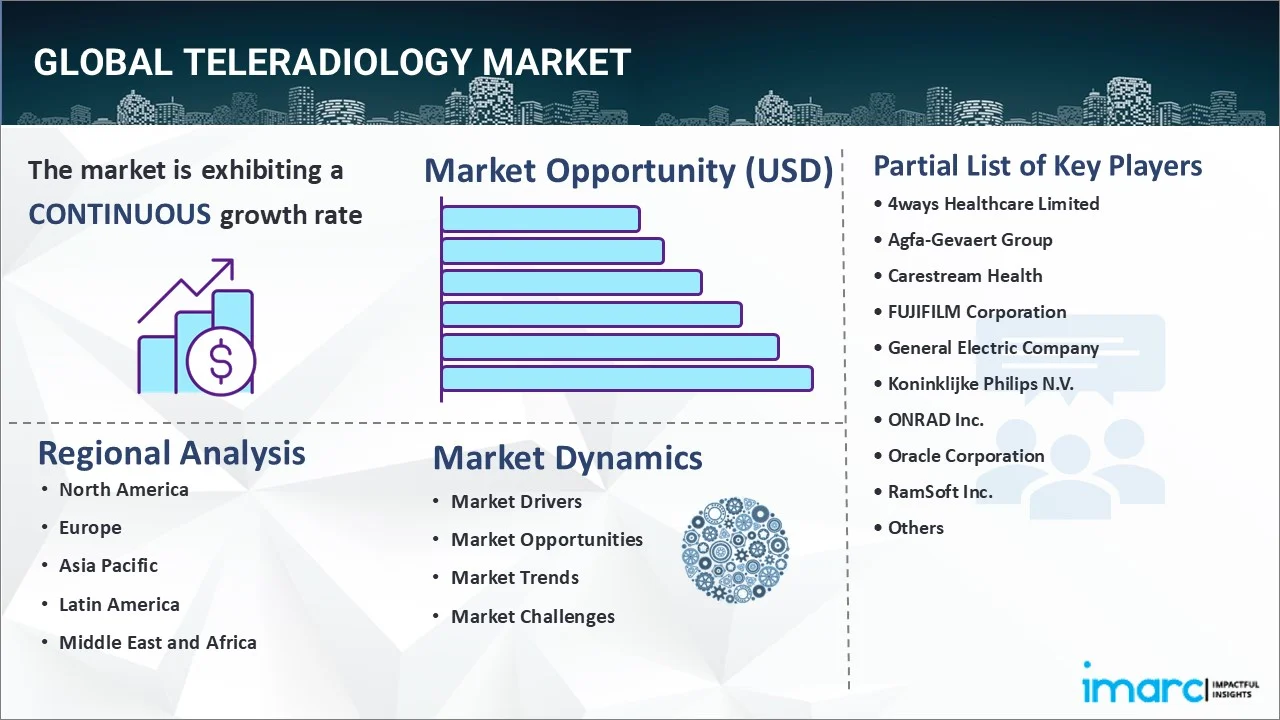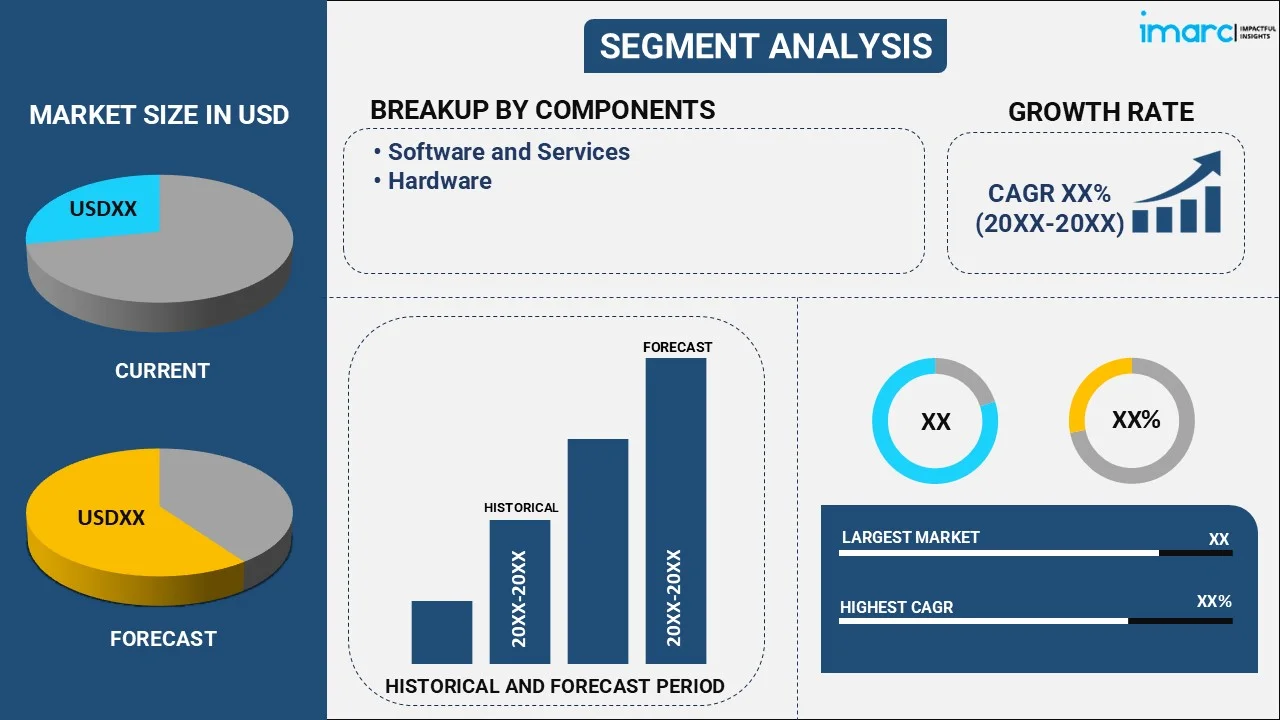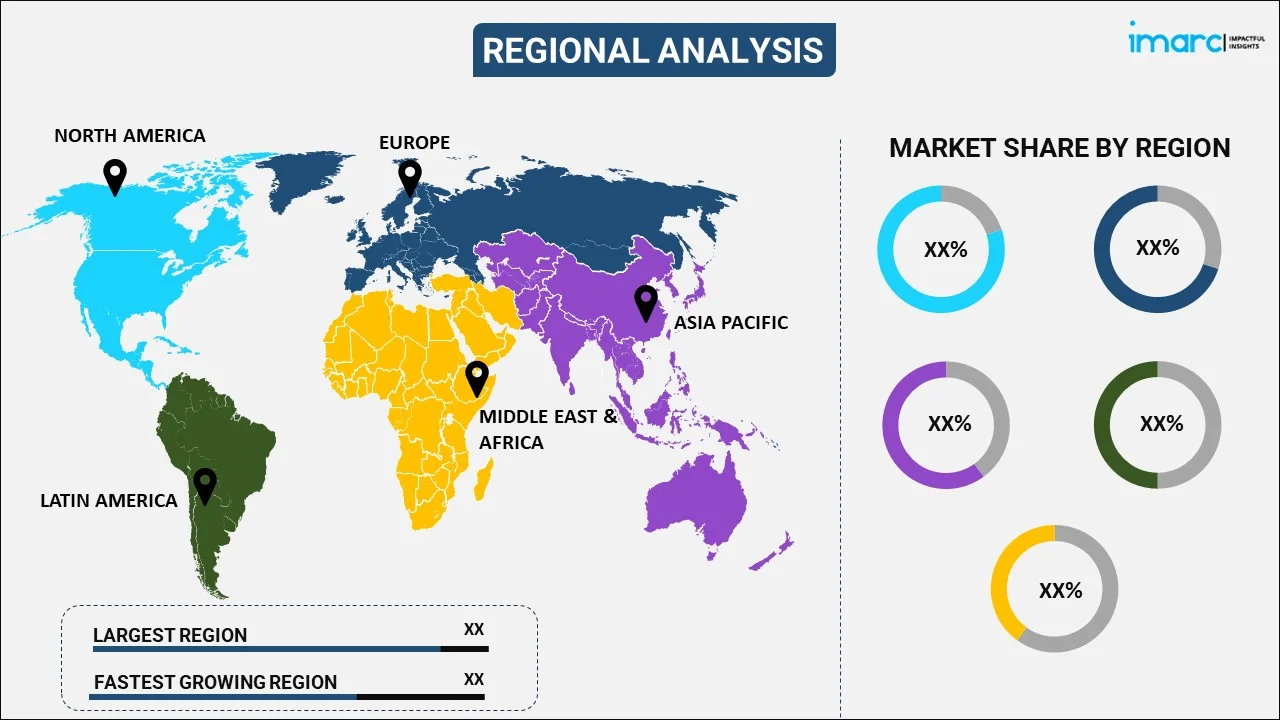
Teleradiology Market Report by Component (Software and Services, Hardware), Imaging Technique (X-rays, Computed Tomography (CT), Ultrasound, Magnetic Resonance Imaging (MRI), Nuclear Imaging, and Others), End User (Hospitals and Clinics, Ambulatory Surgical Centers, Diagnostic Centers, and Others), and Region 2025-2033
Teleradiology Market:
The global teleradiology market size reached USD 6.6 Billion in 2024. Looking forward, IMARC Group expects the market to reach USD 20.1 Billion by 2033, exhibiting a growth rate (CAGR) of 13.2% during 2025-2033. The market is primarily driven by the emerging trend of digitalization, the ongoing technological advancements, the integration of machine learning (ML) and artificial intelligence technologies, and the rising focus of the healthcare industry on resource optimization and cost-efficiency.
|
Report Attribute
|
Key Statistics
|
|---|---|
|
Base Year
|
2024 |
|
Forecast Years
|
2025-2033
|
|
Historical Years
|
2019-2024
|
| Market Size in 2024 | USD 6.6 Billion |
| Market Forecast in 2033 | USD 20.1 Billion |
| Market Growth Rate 2025-2033 |
13.2%
|
Teleradiology Market Analysis:
- Major Market Drivers: The continuous advances in telecommunications technology, such as secure data transmission protocols, high-speed internet, and image compression algorithms are catalyzing the teleradiology market growth. Besides this, the extensive utilization of innovative techniques by healthcare providers to obtain radiological interpretations quickly and allow faster diagnosis and treatment decisions, is further stimulating the teleradiology market statistics.
- Key Market Trends: The integration of machine learning and deep learning models by radiologists for triage, image analysis, and decision-making is propelling the teleradiology market demand. Moreover, the growing popularity of cloud computing for providing scalable, secure, and accessible processing and storage infrastructure for medical data and images is also bolstering the teleradiology market trends.
- Competitive Landscape: Some of the major market players in the teleradiology market share include 4ways Healthcare Limited, Agfa-Gevaert Group, Carestream Health, FUJIFILM Corporation, General Electric Company, Koninklijke Philips N.V., ONRAD Inc., Oracle Corporation, RamSoft Inc., Siemens AG, Teleradiology Solutions, USARAD Holdings Inc., among many others.
- Geographical Trends: North America accounted for the largest share in the teleradiology market analysis, owing to its advanced medical care infrastructure. In addition to this, the rising usage of digital technologies and the increasing number of healthcare facilities are also propelling the teleradiology market outlook in North America.
- Challenges and Opportunities: One of the major challenges of the teleradiology market value includes ensuring the privacy and security of medical images and patient health information. However, the growing popularity of telemedicine, which enables remote consultation, diagnosis, and treatment planning in various medical specialties, is presenting significant growth opportunities for the teleradiology market revenue.

Teleradiology Market Trends:
Technological Advancements
The emerging trend of digitalization, the continuous technological advancements, and the rising shift towards digital radiography and picture archiving and communication systems (PACS) are primarily driving the teleradiology market statistics. For instance, 5C Network has launched its artificial intelligence-powered platform Prodigi to interpret radiology images directly from the cloud. This state-of-the-art platform enables teleradiology at a massive scale and makes it possible for diagnostic centers and hospitals to submit scans and access reports. Moreover, the radiology tech firm OpenRad has introduced an enterprise remote reporting platform at the Radiological Society of North America (RSNA). In addition to this, Fujifilm India Pvt. Ltd., has launched a mobile digital radiology system - FDR nano. Furthermore, as per the article published by the Lancet Journal in April 2023, teleradiology software, combined with AI and mobile digital imaging units, can address radiologist shortages, and strengthen various programs aimed at population screening and emergency care.
Globalization of Healthcare Services
The emerging trend of globalization of healthcare services and the ongoing innovations in telecommunications and secure data transfer protocols are stimulating the teleradiology market growth. Moreover, the shifting individual preferences towards second opinions or specialized expertise from radiologists across various countries are also catalyzing the global market. For example, as per the article published in Oxford Academic, the Government of India implemented teleradiology during the pandemic and launched the CollabDDS Online Radiology Services (CORS) initiative. CORS is a web-based interface that provides an integrated online environment between remote health centers and expert radiologists and doctors in tertiary healthcare facilities to visualize and study radiological images in real time.
Focus on Cost-Efficiency and Healthcare Resource Optimization
The elevating focus of the leading players on resource optimization and cost-efficiency in the healthcare industry is positively influencing the market growth. In addition to this, the integration of innovative technologies that allow healthcare providers to access remote radiological expertise on an as-needed basis is propelling the teleradiology market analysis. For instance, as per the data updated by the National Institutes of Health (NIH), in March 2023, the United States healthcare expenditure in biomedical imaging rose from US$ 2,774 Million in the past year to US$ 3,101 Million in the current year. Moreover, in March 2023, United Imaging Healthcare launched a whole-body ultra-high field 5.0T MRI. Additionally, as per the National Health Expenditure Projections 2023-2024, growth rates in United States health expenditures are projected to be 5% in the last year and 5.1% in the current year.
Teleradiology Market Segmentation:
IMARC Group provides an analysis of the key trends in each segment of the market, along with forecasts at the global, regional and country levels for 2025-2033. Our report has categorized the market based on component, imaging technique, and end user.
Breakup by Component:

- Software and Services
- Hardware
Software and services accounts for the majority of the market share
The report has provided a detailed breakup and analysis of the market based on the component. This includes software and services and hardware. According to the report, software and services represented the largest segment.
The growing popularity of picture archiving and communication systems (PACS) and radiology information systems (RIS) for the efficient management and procurement of radiological data is positively influencing the market growth. For instance, Philips has introduced new AI-enhanced informatics solutions to increase diagnostic confidence with intelligence at every step of the radiology workflow at RSNA. A new integrated diagnostic approach connects radiology, cardiology, pathology, and oncology to securely unite data and images across the enterprise, enabling earlier and more definitive diagnoses.
Breakup by Imaging Technique:
- X-rays
- Computed Tomography (CT)
- Ultrasound
- Magnetic Resonance Imaging (MRI)
- Nuclear Imaging
- Others
X-rays hold the largest share in the industry
The report has provided a detailed breakup and analysis of the market based on the imaging technique. This includes X-rays, computed tomography (CT), ultrasound, magnetic resonance imaging (MRI), nuclear imaging, and others. According to the report, X-rays represented the largest market segment. X-rays allow for the remote interpretation of medical images, offering timely diagnosis for various conditions, including lung infections, fractures, and dental aliments.
Breakup by End User:
- Hospitals and Clinics
- Ambulatory Surgical Centers
- Diagnostic Centers
- Others
Hospitals and clinics account for the majority of the market share
The report has provided a detailed breakup and analysis of the market based on the end user. This includes hospitals and clinics, ambulatory surgical centers, diagnostic centers, and others. According to the report, hospitals and clinics accounted for the largest segment.
Hospitals and clinics extensively utilize teleradiology services to acquire remote access for timely interpretation of medical images, including MRIs, X-rays, and CT scans. This aids in enhancing the overall efficiency of healthcare delivery.
Breakup by Region:

- North America
- United States
- Canada
- Asia-Pacific
- China
- Japan
- India
- South Korea
- Australia
- Indonesia
- Others
- Europe
- Germany
- France
- United Kingdom
- Italy
- Spain
- Russia
- Others
- Latin America
- Brazil
- Mexico
- Others
- Middle East and Africa
North America leads the market, accounting for the largest teleradiology market share
The report has also provided a comprehensive analysis of all the major regional markets, which include North America (the United States and Canada); Asia Pacific (China, Japan, India, South Korea, Australia, Indonesia, and others); Europe (Germany, France, the United Kingdom, Italy, Spain, Russia, and others); Latin America (Brazil, Mexico, and others); and the Middle East and Africa. According to the report, North America accounted for the largest market share, owing to its advanced healthcare infrastructure and a well-established regulatory framework.
For instance, as per the data updated by the National Institutes of Health (NIH), in March 2023, the United States healthcare expenditure in biomedical imaging rose from US$ 2,774 Million in the past year to US$ 3,101 Million in the current year. Besides this, the presence of various leading teleradiology service providers and the ongoing technological innovations are also propelling the market growth in this region. For example, Royal Philips launched the Ultrasound Workspace at the American College of Cardiology's Annual Scientific Session & Expo (ACC). This vendor-neutral echocardiography image analysis and reporting solution can be accessed remotely via a browser, enabling clinicians to utilize seamless diagnostic workflows from the ultrasound exam room to the reporting room and beyond, wherever echocardiography data needs to be reviewed and analyzed. Moreover, Leveljump Healthcare Corp's subsidiary, Canadian Teleradiology Services, has signed definitive agreements to acquire four diagnostic imaging clinics, also known as independent healthcare facilities (IHFs), from private Alberta vendors.
Competitive Landscape:
The market research report has also provided a comprehensive analysis of the competitive landscape in the market. Competitive analysis such as market structure, key player positioning, top winning strategies, competitive dashboard, and company evaluation quadrant has been covered in the report. Also, detailed profiles of all major companies have been provided. Some of the major market players in the Teleradiology industry include:
- 4ways Healthcare Limited
- Agfa-Gevaert Group
- Carestream Health
- FUJIFILM Corporation
- General Electric Company
- Koninklijke Philips N.V.
- ONRAD Inc.
- Oracle Corporation
- RamSoft Inc.
- Siemens AG
- Teleradiology Solutions
- USARAD Holdings Inc.
(Please note that this is only a partial list of the key players, and the complete list is provided in the report.)
Teleradiology Market News:
- February 2024: Yellowcross Healthcare Commerce, a telemedicine practice management organization, launched a new consultancy service to help medical groups and healthcare facilities expand their remote care capabilities. The new company is founded by experienced healthcare and IT industry professionals Robb Vaules and Kent Thomas.
- April 2023: Aster DM Healthcare opened its Telecommand Center and Digital Health facility in India, which uses cutting-edge technology to provide all telehealth services under one roof, including teleradiology.
- October 2023: Cairo-based teleradiology vendor Rology has received 510(k) clearance from the U.S. Food and Drug Administration (FDA), allowing its platform to be used by providers in the United States. Rology teleradiology is designed to link a clinician or healthcare organization’s patients to a skilled radiologist from anywhere, facilitating rapid report readings. The platform acts as a remote radiology department, made up of a suite of modules that include features such as automatic image acquisition, workflow integration, reporting support, and more. All of the modules were cleared for use by the FDA.
Teleradiology Market Report Scope:
| Report Features | Details |
|---|---|
| Base Year of the Analysis | 2024 |
| Historical Period | 2019-2024 |
| Forecast Period | 2025-2033 |
| Units | Billion USD |
| Scope of the Report | Exploration of Historical Trends and Market Outlook, Industry Catalysts and Challenges, Segment-Wise Historical and Future Market Assessment:
|
| Components Covered | Software and Services, Hardware |
| Imaging Techniques Covered | X-rays, Computed Tomography (CT), Ultrasound, Magnetic Resonance Imaging (MRI), Nuclear Imaging, Others |
| End Users Covered | Hospitals and Clinics, Ambulatory Surgical Centers, Diagnostic Centers, Others |
| Regions Covered | Asia Pacific, Europe, North America, Latin America, Middle East and Africa |
| Countries Covered | United States, Canada, Germany, France, United Kingdom, Italy, Spain, Russia, China, Japan, India, South Korea, Australia, Indonesia, Brazil, Mexico |
| Companies Covered | 4ways Healthcare Limited, Agfa-Gevaert Group, Carestream Health, FUJIFILM Corporation, General Electric Company, Koninklijke Philips N.V., ONRAD Inc., Oracle Corporation, RamSoft Inc., Siemens AG, Teleradiology Solutions, USARAD Holdings Inc., etc. |
| Customization Scope | 10% Free Customization |
| Post-Sale Analyst Support | 10-12 Weeks |
| Delivery Format | PDF and Excel through Email (We can also provide the editable version of the report in PPT/Word format on special request) |
Key Benefits for Stakeholders:
- IMARC’s industry report offers a comprehensive quantitative analysis of various market segments, historical and current market trends, market forecasts, and dynamics of the teleradiology market from 2019-2033.
- The research report provides the latest information on the market drivers, challenges, and opportunities in the global teleradiology market.
- The study maps the leading, as well as the fastest-growing, regional markets. It further enables stakeholders to identify the key country-level markets within each region.
- Porter's five forces analysis assists stakeholders in assessing the impact of new entrants, competitive rivalry, supplier power, buyer power, and the threat of substitution. It helps stakeholders to analyze the level of competition within the teleradiology industry and its attractiveness.
- The competitive landscape allows stakeholders to understand their competitive environment and provides insight into the current positions of key players in the market.
Key Questions Answered in This Report
The teleradiology market was valued at USD 6.6 Billion in 2024.
We expect the global teleradiology market to exhibit a CAGR of 13.2% during 2025-2033.
The rising integration of advanced technologies, such as Artificial Intelligence (AI) and Machine Learning (ML), with teleradiology to automatically detect complex anomalous patterns in image data and provide an assistive diagnosis for patients, is primarily driving the global teleradiology market.
The sudden outbreak of the COVID-19 pandemic has led to the growing adoption of teleradiology services for accurate diagnosis and treatment of the coronavirus-infected patients requiring urgent medical attention.
Based on the component, the global teleradiology market can be segmented into software and services and hardware. Currently, software and services hold the largest market share.
Based on the imaging technique, the global teleradiology market has been categorized into X-rays, Computed Tomography (CT), ultrasound, Magnetic Resonance Imaging (MRI), nuclear imaging, and others. Among these, X-rays currently exhibit clear dominance in the market.
Based on the end user, the global teleradiology market can be bifurcated into hospitals and clinics, ambulatory surgical centers, diagnostic centers, and others. Currently, hospitals and clinics account for the majority of the total market share.
On a regional level, the market has been classified into North America, Asia-Pacific, Europe, Latin America, and Middle East and Africa, where North America currently dominates the global teleradiology market.
Some of the major players in the global teleradiology market include 4ways Healthcare Limited, Agfa-Gevaert Group, Carestream Health, FUJIFILM Corporation, General Electric Company, Koninklijke Philips N.V., ONRAD Inc., Oracle Corporation, RamSoft Inc., Siemens AG, Teleradiology Solutions and USARAD Holdings Inc.
Need more help?
- Speak to our experienced analysts for insights on the current market scenarios.
- Include additional segments and countries to customize the report as per your requirement.
- Gain an unparalleled competitive advantage in your domain by understanding how to utilize the report and positively impacting your operations and revenue.
- For further assistance, please connect with our analysts.
 Inquire Before Buying
Inquire Before Buying
 Speak to an Analyst
Speak to an Analyst
 Request Brochure
Request Brochure
 Request Customization
Request Customization




.webp)




.webp)












